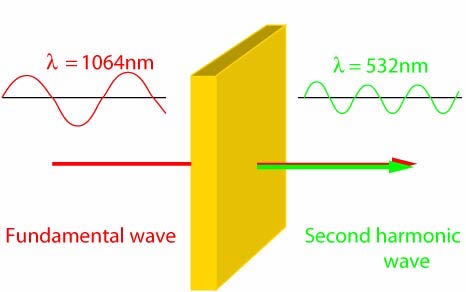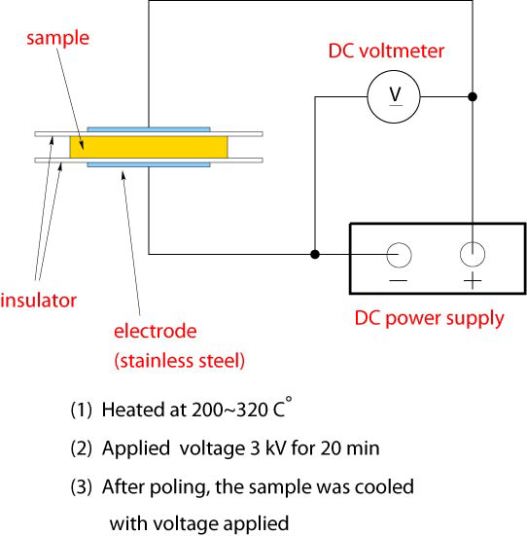Previous research
Second-Harmonic Generation (SHG) from Poled Oxide Glasses
Second-harmonic generation (SHG) is a second-order nonlinear phenomenon; a fundamental wave is partially converted into a second-harmonic (SH) wave with twice the initial frequency (Fig.1). SHG is a key technology as a frequency doubler of laser light. SHG from poled glass materials have the focus of growing scientific and practical interest. From the fundamental standpoints, the main interest lies in the fact that the second-order nonlinearity which rigorously needs a lack of inversion symmetry in the light wavelength scale is induced in some kinds of glasses by poling (Fig.2 shows a thermal poling system employed in this work), despite of optical isotropy of glass. The ability to tailor the second-order nonlinearity of poled oxide glass is also important for many practical applications such as the frequency doubler of light and linear electro-optical devices because of its cheaper cost.
SHG measurements by Maker fringe method
SHG was evaluated by Maker fringe measurements. SHG comes from the second-order nonlinear polarization term in a following equation,

where is P the polarization and E is the electric field of an incident light.
As for the poled oxide glasses, Maker fringe method is notably useful because it informs us not only the magnitude of non-zero tensor components of the second-order nonlinear susceptibility but also other important aspects such as symmetry and thickness of a SHG-active structure. An intense laser beam is incident on a plate-like glass sample which is rotated around an axis perpendicular to the incident plane. As a result, SH intensity generated from the poled glass is obtained as a function of incident angle. For details of this analysis of thus-obtained "Maker fringe" patterns, please see references below.
SHG from poled tellurite glasses
Several kinds of glass systems can exhibit SHG when poling is carried out. Among them, tellurite glasses have lower glass transition temperatures in a range of ca. 473-673 K, which are very close to typical thermal poling temperatures. This point is quite interesting because such poling procedures possibly cause a drastic change in glass structures and resultant second-order nonlinearity. Thus, we aimed to clarify the induction mechanism of second-order nonlinearity in tellurite glasses, as well as its optimization for the practical needs. Here, I confine the introduction of our results to a few main topics.
The SH-active structure was induced only in a thin layer with a thickness of tens of microns beneath an anode-side glass surface. This can be explained as follows. The initial stage of poling is a migration of mobile cations. The migration of cations leaves thin space charge layer near the anode, and the external voltage drops drastically in this region. In other words, the large electric field is frozen in the anode-side surface region of glass, leading to SHG. Additionally, it is speculated that, in the vicinity of the glass transition temperature, the induced large electric field leads to an orientation ofasymmetrical tellurite structural units which possess electric dipoles.
There is an optimum poling temperature where the largest second-order nonlinearity could be induced. The optimum poling temperatures clearly exhibit a linear relationship with the glass transition temperatures. An increase in SH intensity with an increase in poling temperature below the optimum poling temperature can be naturally attributed to an increase in the mobility of cations, which form larger electric dipoles. On the other hand, a decrease in SH intensity just below glass transition temperature might be explained by following two mechanisms. One of them is the effect of thermal fluctuation on the orientation of electric dipoles. Another possible explanation is some electrochemical reactions between glass surfaces and electrodes at elevated temperatures. In fact, sometimes we could observe oxidation reactions which reduced the space charge built near the anode-side surface.
This work was done as my doctor thesis under the leadership of Prof. Kazuyuki Hirao and Prof. Katsuhisa Tanaka at Kyoto University. I am grateful for the corporation to this day.
References
- "Induction and relaxation of optical second-order nonlinearity in tellurite glasses", A. Narazaki, K. Tanaka, K. Hirao, and N. Soga, Journal of Applied Physics, 85 (1999) 2046.
- "Poling-induced crystallization of tetragonal BaTiO3 and enhancement of optical second-harmonic intensity in BaO-TiO2-TeO2 glass system", A. Narazaki, K. Tanaka, and K. Hirao, Applied Physics Letters, 75 (1999) 3399.

